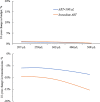Cost-effectiveness and budget impact of immediate antiretroviral therapy initiation for treatment of HIV infection in Côte d'Ivoire: A model-based analysis
- PMID: 31247009
- PMCID: PMC6597104
- DOI: 10.1371/journal.pone.0219068
Cost-effectiveness and budget impact of immediate antiretroviral therapy initiation for treatment of HIV infection in Côte d'Ivoire: A model-based analysis
Abstract
Introduction: The Temprano and START trials provided evidence to support early ART initiation recommendations. We projected long-term clinical and economic outcomes of immediate ART initiation in Côte d'Ivoire.
Methods: We used a mathematical model to compare three potential ART initiation criteria: 1) CD4 <350/μL (ART<350/μL); 2) CD4 <500/μL (ART<500/μL); and 3) ART at presentation (Immediate ART). Outcomes from the model included life expectancy, 10-year medical resource use, incremental cost-effectiveness ratios (ICERs) in $/year of life saved (YLS), and 5-year budget impact. We simulated people with HIV (PWH) in care (mean CD4: 259/μL, SD 198/μL) and transmitted cases. Key input parameters to the analysis included first-line ART efficacy (80% suppression at 6 months) and ART cost ($90/person-year). We assessed cost-effectiveness relative to Côte d'Ivoire's 2017 per capita annual gross domestic product ($1,600).
Results: Immediate ART increased life expectancy by 0.34 years compared to ART<350/μL and 0.17 years compared to ART<500/μL. Immediate ART resulted in 4,500 fewer 10-year transmissions per 170,000 PWH compared to ART<350/μL. In cost-effectiveness analysis, Immediate ART had a 10-year ICER of $680/YLS compared to ART<350/μL, ranging from cost-saving to an ICER of $1,440/YLS as transmission rates varied. ART<500/μL was "dominated" (an inefficient use of resources), compared with Immediate ART. Immediate ART increased the 5-year HIV care budget from $801.9M to $812.6M compared to ART<350/μL.
Conclusions: In Côte d'Ivoire, immediate compared to later ART initiation will increase life expectancy, decrease HIV transmission, and be cost-effective over the long-term, with modest budget impact. Immediate ART initiation is an appropriate, high-value standard of care in Côte d'Ivoire and similar settings.
Conflict of interest statement
The authors have declared that no competing interests exist.
Figures



Similar articles
-
Laboratory Monitoring of Antiretroviral Therapy for HIV Infection: Cost-Effectiveness and Budget Impact of Current and Novel Strategies.Clin Infect Dis. 2016 Jun 1;62(11):1454-1462. doi: 10.1093/cid/ciw117. Epub 2016 Mar 1. Clin Infect Dis. 2016. PMID: 26936666 Free PMC article.
-
Cost-effectiveness of HIV treatment in resource-poor settings--the case of Côte d'Ivoire.N Engl J Med. 2006 Sep 14;355(11):1141-53. doi: 10.1056/NEJMsa060247. N Engl J Med. 2006. PMID: 16971720
-
Cost-effectiveness of preventing loss to follow-up in HIV treatment programs: a Côte d'Ivoire appraisal.PLoS Med. 2009 Oct;6(10):e1000173. doi: 10.1371/journal.pmed.1000173. Epub 2009 Oct 27. PLoS Med. 2009. PMID: 19859538 Free PMC article.
-
Estimating HIV Management and Comorbidity Costs Among Aging HIV Patients in the United States: A Systematic Review.J Manag Care Spec Pharm. 2020 Feb;26(2):104-116. doi: 10.18553/jmcp.2020.26.2.104. J Manag Care Spec Pharm. 2020. PMID: 32011956 Free PMC article.
-
Economic evaluation of ART in resource-limited countries.Curr Opin HIV AIDS. 2010 May;5(3):225-31. doi: 10.1097/COH.0b013e3283384a9d. Curr Opin HIV AIDS. 2010. PMID: 20539078 Free PMC article. Review.
Cited by
-
Evaluating Point-of-Care Nucleic Acid Tests in Adult Human Immunodeficiency Virus Diagnostic Strategies: A Côte d'Ivoire Modeling Analysis.Open Forum Infect Dis. 2021 May 13;8(6):ofab225. doi: 10.1093/ofid/ofab225. eCollection 2021 Jun. Open Forum Infect Dis. 2021. PMID: 34189169 Free PMC article.
-
An Enhanced Retention Strategy to Prevent the Vertical Transmission of HIV in Uganda: A Budget Impact Analysis.Pharmacoecon Open. 2025 Sep;9(5):815-825. doi: 10.1007/s41669-025-00587-x. Epub 2025 Jun 8. Pharmacoecon Open. 2025. PMID: 40483642
-
Real-world clinical and economic outcomes from rapid start antiretroviral therapy in HIV: systematic review and meta-analysis.AIDS. 2025 Mar 1;39(3):241-252. doi: 10.1097/QAD.0000000000004046. Epub 2024 Oct 24. AIDS. 2025. PMID: 39453866 Free PMC article.
-
Optimizing healthcare for blood donors at risk of transfusion-transmissible infections: pre-implementation mixed methods protocol.Glob Health Action. 2025 Dec;18(1):2540685. doi: 10.1080/16549716.2025.2540685. Epub 2025 Aug 12. Glob Health Action. 2025. PMID: 40791059 Free PMC article.
-
Optimizing infant HIV diagnosis with additional screening at immunization clinics in three sub-Saharan African settings: a cost-effectiveness analysis.J Int AIDS Soc. 2021 Jan;24(1):e25651. doi: 10.1002/jia2.25651. J Int AIDS Soc. 2021. PMID: 33474817 Free PMC article.
References
-
- Grinsztejn B, Hosseinipour MC, Ribaudo HJ, Swindells S, Eron J, Chen YQ, et al. Effects of early versus delayed initiation of antiretroviral treatment on clinical outcomes of HIV-1 infection: results from the phase 3 HPTN 052 randomised controlled trial. Lancet Infect Dis. 2014. April;14(4):281–90. 10.1016/S1473-3099(13)70692-3 - DOI - PMC - PubMed
-
- World Health Organization. 2006. Antiretroviral therapy For HIV infection in adults and adolescents: recommendations for a public health approach (2006 revision). Accessed 24 May 2019 at http://www.who.int/hiv/pub/guidelines/artadultguidelines.pdf. - PubMed
-
- World Health Organization. 2010. Antiretroviral therapy for HIV infection in adults and adolescents; recommendations for a public health approach (2010 version). Accessed 24 May 2019 at http://www.who.int/hiv/pub/arv/adult2010/en/index.html. - PubMed
Publication types
MeSH terms
Substances
Grants and funding
LinkOut - more resources
Full Text Sources
Medical
Research Materials

